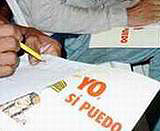The Light of Education Reaches the Darkest Corners of the World
 When the Cuban Revolution took power in January, 1959, the State traced out a plan consisting on conveying Education to a place of honor, not only in the island nation, but also to take it to other parts of the world. Supportive Cuba has been stretching a hand of friendship to other Third World countries since then.
When the Cuban Revolution took power in January, 1959, the State traced out a plan consisting on conveying Education to a place of honor, not only in the island nation, but also to take it to other parts of the world. Supportive Cuba has been stretching a hand of friendship to other Third World countries since then.
The first steps of collaboration on this field took place in the first half of the 1960s when scholarships were granted to students hailing from Asia, Africa and Latin America, who came to Cuba to study different branches of the human knowledge in secondary and higher education levels.
So far, more than 30,000 foreign students coming from 114 countries have graduated from our technical schools, highest institutions or universities. Besides, myriads of foreigners upgraded their scientific degrees through training and postgraduate courses.
Through history more than 26,000 of our teachers and professors have offered their services in 31 countries of Africa, Latin America and the Caribbean, and the highlights of this collaboration have been the literacy campaigns in Angola, Venezuela, Bolivia and Nicaragua, as well as in other countries where the innovative “Yo si puedo” method has been implemented.
By the end of the 20th century Haiti requested Cuba to help them in a literacy campaign. Thousand of Haitians were alphabetized thanks to an experimental method which consisted on 54 radio broadcastings. For this innovative and effective collaboration, the country received several international recognition and acclaim.
In spite of Cuba’s plights, the socialist State offers a helping hand those in need, sparing neither material resources nor human effort in a struggle against ignorance. (Translated by Gualveris Rosales Sanchez)


